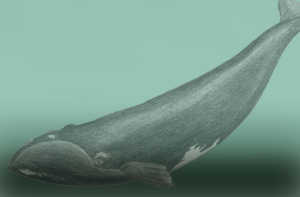Whaling boat
Whaling boats - or scoops - feature on the coats-of-arms of
the towns of Hondarribia, Bermeo and Biarritz, dating from
the thirteenth and fourteenth centuries, some indication of
how long the history of Basque whaling stretches back.
The Basques used harpoons, requiring them to get within a
few metres of the whales – evidence not only of the bravery
and skill of the crew, but also of the speed and manoeuvrability
of the vessel.
Thanks to the sixteenth-century Basque whaling boats in
Red Bay, we now have detailed information on the vessels
that played a central role in one of the most heroic episodes
in Basque maritime history.
These txalupas were multi-purpose vessels, and were also
used for fishing for sardine, with a gillnet, and cod, in the
North Atlantic.

Types of whaling boat. Basque, 16th century. New Bedford,
18th century. Azores, 19th century. © José Lopez

Cod from Red Bay. © José Lopez

Beothuk is a replica of the Red Bay whaling boat, built by the
Albaola maritime heritage association at the Ontziola Traditional
Vessel Research and Construction Centre in Pasaia. This vessel, made
to plans provided by Parks Canada, was put to the test in an experimental
archaeological voyage off the coast of Newfoundland in
2006; she travelled over 2,000 kilometres, from Quebec down the
St Lawrence estuary to Red Bay and proved herself to be an excellent
sailor. In the seventeenth century, the French explorer Champlain
used these vessels extensively to explore the rivers of Canada. They
are also known to have been used habitually by some of the native
American tribes of Newfoundland and New England. © José Lopez

Reproduction of the coat-of-arms of Hondarribia, 1266.
The coats-of-arms of Bermeo and Biarritz depict similar scenes,
and can be seen to include the same type of vessel; the ends are
narrow and sharp and above the water line the hull is clinkerbuilt.
Until the mid-sixteenth century this vessel was known as
a galleon. From then on, perhaps coinciding with the adoption
of carvelled planking below the water line, it began to be called
a "chalupa" (txalupa). © José Lopez

The right whale (Eubalaena glacialis) is also known as the free
whale, Basque whale, Biscayan whale and whale of the Basques.
Here it is depicted to the same scale as the “chalupas”. © José Lopez

Lintel of a house in Calle Azara in Zarautz with another whale
hunting scene. The relief shows a very similar chalupa to the one
found in Red Bay; the two upper strakes in the hull, above the
waterline, can be seen to be lapped, whereas the underwater part
is flush-laid. Detail of the lintels clearly showing the whale harpooned
from the txalupa. © José Lopez

By the sixteenth century, the Basque whaling boat had already
reached a very high degree of design sophistication. In later centuries
it was adopted by other seafaring cultures, who maintained
and adapted the principal features. Once such example was the
New Bedford whaling boat, made famous throughout the world by
Herman Melville’s novel Moby Dick. The American boat was in
turn adapted locally in the Azores for hunting whales, and continued
to be used into the twentieth century. It is still used as a racing
vessel. Basque whaling boat from the sixteenth century, recovered at
Red Bay, Labrador by archaeologists from Parks Canada, inunderwater excavations of the Pasai Donibane nao, sunk in 1565.
This is the oldest whaling boat known and is in the Basque whaling
museum at the National Historic Site at Red Bay. She is eight metres
in length and two in the beam. She is built primarily of oak,
and the most striking feature of her design is that it combines the
two systems: clinker-built above the waterline and carvelled below
it. She sported a fore mast and main mast, and had a crew of six
oarsmen (included the harpooner) and a captain. © José Lopez

Shoal of sardines. The Red Bay “chalupa” was designed for whaling but it would
be wrong to think that this was its sole function. The Basques sent
expeditions to these same waters to fish for cod with long lines and
even the whalers fished for cod during off seasons. Along the Basque
coast, the chalupa was used not only for whaling but also for netting
sardines and probably also for other forms of fishing. © José Lopez












